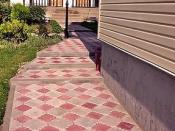Search
Login
Recommended
How to insulate the facade of a country house and create a beautiful appearance
By warming the facade of a country house, thereby reducing heating costs, increasing the comfort of living, however, the appearance of the house is much better - the house becomes like in the picture.
Content
- General information
- Stucco facade video
- Hinged facade system or ventilated facade video
- Do-it-yourself ventilated facade device
- Thermopanels video
General information
A box of a house can be built in an accelerated manner using aerated concrete blocks, or similar building materials.
As a result, the construction time is reduced, but the construction is far from comfort, the heat is poorly preserved, the appearance of the house is far from perfect.
Such construction requires the installation of modern high-performance facade insulation.
At present, two schemes of facade insulation are widespread: heat-insulating - related insulation scheme in the form of stucco facade and a hinged insulation scheme in the form of a ventilated facade.
When installing a plaster facade, all components of the thermal insulation system are connected together, as a result, a multilayer structure common with the base wall is formed.
Mounting warm stucco facade It is a wet and dirty process.
Popularly, such a system is called a wet type system.
Since the work is connected with plaster, when lowering the temperature of the outside air and achieving negative indicators, the plastering work must be stopped.
A hinged system or a ventilated facade is a frame cladding that connects to the house at specific points.
Such work is a dry type work.
Ventilated facades can be installed at any time of the year.
But, it is necessary to comply with the installation technology, use all materials and high-quality fasteners.
Compliance with the rules of facade insulation technology will save the house from an emergency and will not allow to destroy the system of ventilated facades.
Stucco facade
Modern building materials are designed for the installation of a stucco facade.
When working using a special adhesive composition, various plasters, reinforcing polymer nets.
A very important point is the use of all components of one manufacturer.
Components of various manufacturers may not take root with each other - this can lead to the destruction of the entire thermal insulation system.
At the same time, if the components are produced by one manufacturer, they are able to perfectly fix the insulation layer and protect it from external influences.
The stucco facade can be thin-layer and thick-layer.
A thin-layer plaster facade can only be installed on well-aligned walls, the thickness of the plaster finish is not higher than 10 mm.
Insulation for such systems are heat-insulating boards made of mineral wool, polystyrene foam or facade polystyrene.
With thick-layer facades, the thickness of the finishing layers reaches 40 mm.
Typically, thick facades are used for uneven walls. The heat-insulating sheath of such facades is only mineral wool, and they also use branded steel mesh and special dowels.
For an example of work on warming a house from foam concrete blocks, you can use plaster
rockFacade thermal insulation system.
This system consists of mineral plates Facade Butts, in addition to this includes a set of fixing and finishing materials, fasteners.
All components interact well with each other.
The result of the work is a reliable, durable facade.
The work is carried out as follows:
- The surface of the house is primed, at the base level, a guide aluminum profile is attached.
- Heat-insulating slabs made of stone wool are glued over the entire area of \u200b\u200bthe wall.
- For reliability, the insulation is additionally fixed with facade dowels, which have a wide plastic hat.
- A reinforcing polymer mesh is superimposed and fastened on top of the insulation, while window and door openings are especially carefully glued.
- The entire facade is plastered with a special cement-based plaster-glue mixture.
- A layer of reinforcing mortar is applied over the plaster.
- Structural decorative plaster is applied over the reinforcing mortar.
- Various types of finishing are used: they produce structural plaster, mosaic, tile or stone cladding.
Hinged facade system or ventilated facade
The installation technology of mounted facade systems is conventionally divided into factory and home-made.
The factory hinged facade system is manufactured by a specialized company for a specific object and is supplied comprehensively.
- The package includes a metal substructure, selected insulation, all insulation materials, fasteners, exterior panels, etc.
- The whole system is assembled by specialists on site according to the working drawings.
- First, special attention must be paid to the preparation of the work surface.
- Walls must be free of dirt.
- Dust must be removed, the walls are cleaned of oil stains, residual mortar and flaking plaster are removed.
- All cracks must be repaired.
- In no case can you fix the insulation on the walls affected by the fungus - infected areas must be treated with a special compound.
- An important point in the installation of a ventilated facade is the creation of an air gap between the insulation and the front trim.
Correctly performed work on the front decoration preserves the house for many years.
Do-it-yourself ventilated facade device
Our craftsmen mainly arrange a ventilated facade in a folk way.
Wooden beams or a galvanized steel profile are prepared, with their help a frame structure is being erected.
The entire space between the racks is filled with mineral thermal insulation from stone wool, so the racks are installed based on the tight installation of stone wool between them.
As a protective decorative screen, commonly used vinyl siding.
Sometimes the frame is sheathed with DSP, or with glass-magnesite sheets, plaster is made on top of the sheets or faced with tile or stone.
As with factory installation, an air gap is left between the insulation and the screen.
Moving air streams erode moisture condensation.
Thermopanels
If necessary, when it is required to quickly and efficiently insulate the house from the outside - use thermal panels.
Thermal panels are made on the basis of polystyrene foam, the thickness of such panels is from 40 to 100 mm.
Thermal panels are also made on the basis of polyurethane foam - the thickness of such panels is 25-40 mm.
On the outside of the thermal panels, cladding brick, porcelain stoneware, ceramic tiles or artificial stone are applied.
Using thermal panels - you get a beautiful look at home in a few days.
The main requirement is smooth walls.
With the help of self-tapping screws, thermal panels are attached to the walls, then, using colored mineral grout, the tile joints are filled.
To impart water-repellent properties to tiles, tiles are treated with a water repellent.
Thermopanels have high elasticity, they are well suited to curved surfaces, when moving the foundation, well adapted to deformation.





